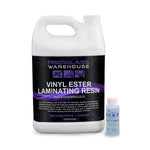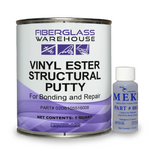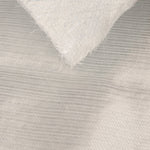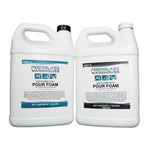You have no items in your shopping cart.
Epoxy laminating resins are a versatile and durable solution for creating strong and lasting products. These resins offer superior bonding and sealing properties, making them suitable for use in a wide range of applications. They are also highly resistant to water, moisture, chemicals, heat, abrasion and fatigue, meaning they can be used in both indoor and outdoor environments. By combining different layers of epoxy laminating resin, it is possible to create products that have increased strength, durability and attractiveness compared to traditional plastics or other materials. This makes them ideal for use in the manufacturing of furniture, surfboards, automobiles, boats and much more!
What are Laminating Epoxy Resins:
Laminating epoxy resins are thermosetting polymers which provide superior adhesion, chemical resistance and physical properties when used as a coating or adhesive on composite surfaces. They have been around for decades, but their use has become more important in recent years as the demand for higher-strength and durable products grows. Epoxy resins are often used to laminate layers of composite materials together in a process known as lamination. This process is commonly used for applications such as boat hulls, automotive bodies, and other industrial products that require a strong bond between various materials.
Epoxy laminating resins come with a Part A side which is the epoxy resin and a Part B side which is the hardener. The hardener comes in three speeds- fast, medium and slow. The cure times vary depending on the room temperature and which speed hardener is used.
For a 2:1 epoxy laminating resin, gel times at 77 degrees Fahrenheit are approximately-
Fast: 12- 18 minutes
Medium: 20-30 minutes
Slow: 45-60 minutes
For a 4:1 epoxy laminating resin, gel times at 77 degrees Fahrenheit are approximately-
Fast: 10-15 minutes
Medium: 20-25 minutes
Slow: 30-35 minutes

The Benefits of Laminating Epoxy Resins:
The use of epoxy laminating resins offers several advantages over traditional plastics or other resins. Firstly, they can provide superior adhesion and strength when bonding layers of material together, which makes them suitable for use in complex composite structures. They work well for both lamination and as an adhesive that can be used with fillers. Secondly, they have low shrinkage and excellent flexural strength. Thirdly, they offer increased protection against water, moisture, chemicals and abrasion. Lastly, they are incredibly durable and can withstand high temperatures.
**While epoxy resins cannot be used with chopped strand mat, they can be used on Styrofoam.
Why Choose Epoxy over Polyester and Vinyl Ester:
Not only is epoxy resin stronger than polyester or vinyl ester resin but it has significantly less odor. Polyester and vinyl ester resin both have styrene which puts off a strong smell. Epoxy resin does not contain styrene so its odor is not as overwhelming. Also, vinyl ester resin tends to yellow much quicker than epoxy resins.
Epoxy resin does need to be mixed and measured more accurately and thoroughly than other resins to turn out successfully but it does provide a good working time. Epoxy resin also has a much longer shelf life. Polyester is typically around 6 months, vinyl ester at 3 months and epoxy resins if stored correctly can last several years.
Difference between 2:1 and 4:1 epoxy laminating resin:
Epoxy resins come in a variety of ratios, depending on the desired application. The most commonly used ratios are 2:1 and 4:1. A 1:1 epoxy resin is not typically used as a laminating resin as it is not as strong. It is often used for river tables, table coatings and art including jewelry. It is not recommended to be used with fiberglass or other reinforcements. For more information on a 1:1 epoxy resin, click here.
A 2:1 and 4:1 epoxy resin are popular laminating epoxies and can be used as an adhesive on its own, with a filler or can be used with fiberglass or other reinforcements such as carbon fiber or Kevlar. They are more rigid and provide better physical properties such as strength, chemical resistance, abrasion resistance and heat resistance. A 2:1 is softer, more flexible, and easier to measure out than a 4:1. This makes it the most popular laminating epoxy. If you need a strong part that won’t flex much, you will want to go with a 4:1 epoxy.

Pros and Cons of Epoxy laminating Resin:
The main advantages of using laminating epoxy resins are their bonding properties as well as their resistance to a variety of conditions such as moisture and temperature changes. It has a fast wet out and a long pot life. It can handle stress better than other resins and will adhere to most surfaces. It works well with many fillers for repair work and gap filling.
A disadvantage to laminating epoxies is that it requires extra time for prep to make sure you measure and mix correctly. Epoxy is more temperamental than polyester and vinyl ester resins and requires exact measurements. It must be mixed completely in order for it to cure and bond correctly. Epoxy is also difficult to sand compared to other resins because it is so strong.
Epoxy is more expensive than polyester and vinyl ester resins because it is superior in so many ways. If you have a large part you are working on, you may want to consider polyester or vinyl ester. If you are working with both polyester/vinyl ester and epoxy resin, make sure you know that epoxy will bond to a polyester surface but not the other way around. So, if you plan to use a polyester gel coat over your epoxy work, whether it be new construction or a repair, you will want to reconsider. Polyester resin or gel coat will not adhere to an epoxy resin surface.
Conclusion:
Laminating epoxy resins are a great way to create strong products. They offer superior bonding capability, good chemical and water resistance, great flexibility and physical properties that make them suitable for many different applications in both indoor and outdoor environments. The choice of different speed hardeners makes it more accommodating than other resins. With epoxy resin’s increased strength and durability compared to traditional plastics or other materials they are an ideal choice when it comes to creating high quality products that can stand the test of time.
** For best results, epoxy resin, like other resins, should be used in temperatures around 77 degrees Fahrenheit. It is important to work in a well-ventilated area and wear the proper safety clothing including eyewear and gloves.
comments (2)
-

-
 JERRY JONES
JERRY JONESare epoxy resins good for laminating archery bow like carbon to wood. And some archery bow builders(self bows) use heat boxes. Is this necessary? And what is self life after opening and putting top back on. Thanks for answer.










@Jerry- Yes, but not all epoxies are the same. You want an epoxy with high elongation. We unfortunately do not carry one that is good for your specific project.
Epoxies last years on the shelf if kept it in a cool, dry environment.